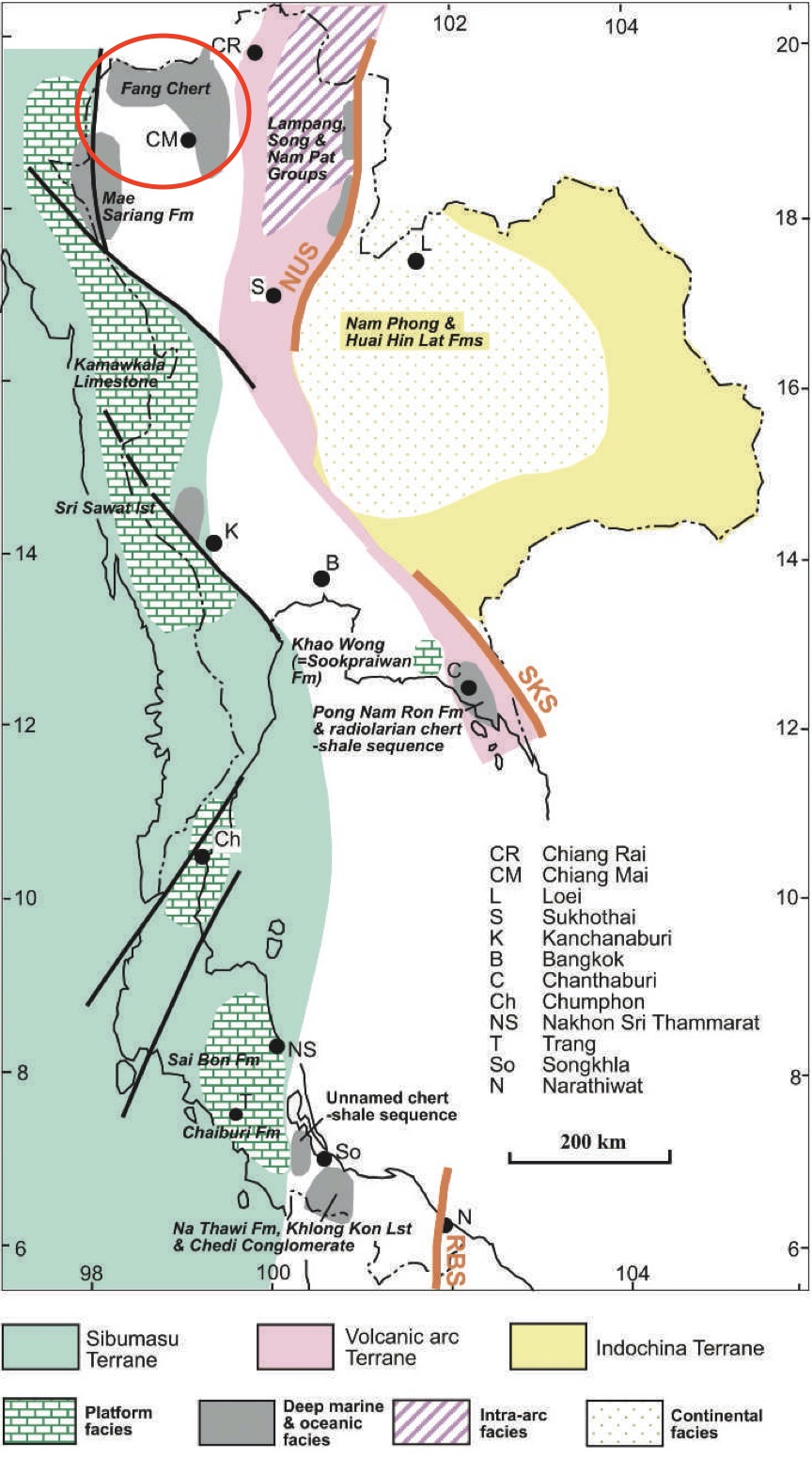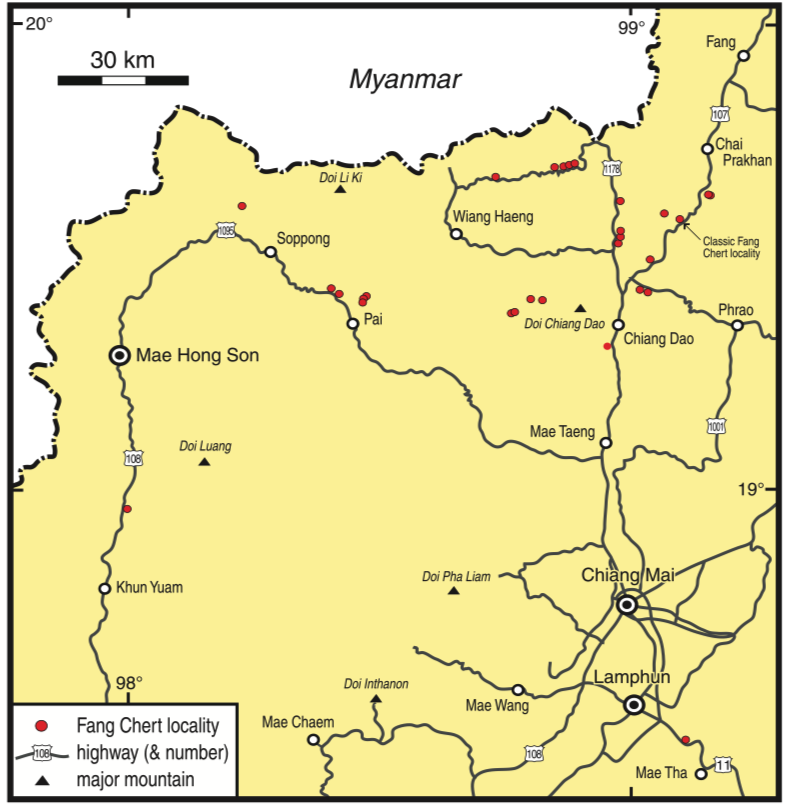Fang Chert Fm
Type Locality and Naming
Km 100-110, Chiang Mai-Fang highway, 42 km south of Fang district, northern Chiang Mai province. Type section is at Km 105.6-106.1.
Synonym: หมวดหินเชิรต์ฝาง
[Figure: Generalized distribution of different Triassic sedimentary environments and some of the more important lithostratigraphic units, and their relations to the terranes. No Triassic volcanic rocks are known in Peninsular Thailand; it therefore appears that either the Sukhothai Terrane existed only in Northern and Southeast Thailand, or that it is present east of the Raub-Bentong Suture. NUS, Nan-Uttaradit Suture; SKS, Sa Kaeo Suture; RBS, Raub-Bentong Suture (Chonglakmani C., 2011, page 146.)]
Lithology and Thickness
Generally well-bedded ribbon chert. The original type section (from bottom to top) consists of over 200 m interbedded grey shale and sandstone often crushed along fault (with graptolites of Emsian age); 100 m well-bedded chert, green, grey and brown in color, with very thin feldspathic shale bands; 70 m black argillite, black carbonaceous shale, rare siltstone band (Perm-Tri boundary interval); 200 m medium-grained, well-bedded sandstone, mudstone and silicified shale, green, greyish- red and brown in color (Olenekian-Anisian). Thickness: 570 m (Bunopas, 1981), no thicker than 200 m (Wonganan and Caridroit, 2005). However, the term, Fang Chert Fm, has now been conventionally applied for siliceous deposits consisting mainly of chert with subordinate siliceous claystone and black carbonaceous shale scattered in northernmost Thailand (Fig. 5.6 in Ueno & Charoentitrat, 2011).
[Figure 5.6 in Ueno & Charoentitrat, 2011 : Map showing distribution of Fang Chert in Northern Thailand based on Caridroit (1993), Sashida et al. (1993a, 1998a, 2000a), Feng et al. (2002, 2004), Wonganan & Caridroit (2005, 2007) and the unpublished data of the author -- Ueno K. & Charoentitirat T. (2011). Note that locality SE of Lamphun reported by Feng et al. (2002) is only provisionally attributed to Fang Chert in the study of Ueno K. & Charoentitirat T. (2011)]
Relationships and Distribution
Lower contact
Upper contact
Not given. Closure of Paleo-Tethys occurred at end of Middle Triassic.
Regional extent
GeoJSON
Fossils
Radiolarians have been the main focus of study (Fig. 5.5 in Ueno & Charoentitrat, 2011, shows the suites of assemblages from Eifelian through Anisian. Lower Devonian graptolites Monograptus hercynicus, Monograptus Yukonensis and Monograptus aequabilis s. ssp. were found in black shale (Jaeger et al. 1968); Middle to Upper Devonian radiolaria Stigmosphaerostylus sp. and Trilonche sp. were found in chert about 30–40 m above the lower black siliceous shale.
Age
Depositional setting
Pelagic sediment in deep ocean. "The above-mentioned radiolarian age-framework is critical in reconstructing the stratigraphic succession of the Fang Chert (Fig. 5.5). Its lowest member is the basal carbonaceous black shale with graptolites of Early Devonian age, which suggests a reducing (anoxic) offshore environment (Hara et al. 2008). That is essentially succeeded by bedded ribbon chert (Fig. 5.4e) which is free from coarser terrigenous siliciclastics (Kamata et al. 2009), whose age ranges from Middle Devonian to Middle Triassic and reverts to a thin interval of black carbonaceous shale and siliceous claystone at around the Permian – Triassic Boundary. Sashida et al. (2000a) reported a continuous succession of Late Permian to Middle Triassic Fang Chert at Ban Huai Tin Tang about 20 km north of Chiang Dao, consisting of bedded radiolarian chert of latest Permian age (Neoalbaillella optima Assemblage) followed by black carbonaceous shale and siliceous claystone. This is then succeeded by bedded chert containing Olenekian radiolarians (Parentactinia nakatsugawaensis Assemblage). A similar facies change was reported from the Permian – Triassic chert successions contained in some Jurassic accretionary complexes of Japan (e.g. Yamakita 1987) which are considered as having been deposited within a Panthalassan pelagic oceanic domain and later incorporated in an accretionary prism by ocean-plate subduction". (Ueno & Charoentitrat, 2011)
Additional Information

